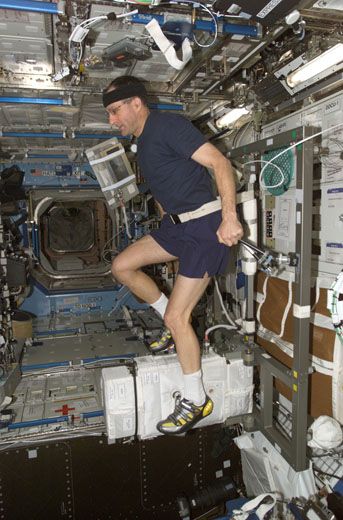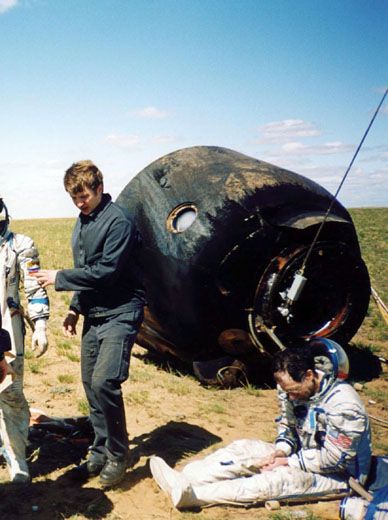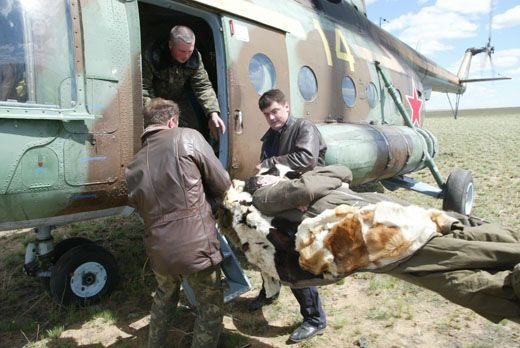If I Were to Land on Mars…
A small malfunction lands three astronauts on Russia’s version of the Red Planet.
/https://tf-cmsv2-smithsonianmag-media.s3.amazonaws.com/filer/pettit-flash.jpg)
Rivulets streamed across my window, breaking up into a chain of droplets like the streamers of rain on an airplane’s window during a landing approach. Only these rivulets, red-orange hot, were driven by a Mach 25 breeze. Our Russian Soyuz capsule had pierced the veil-thin region of Earth’s upper atmosphere at almost five miles per second, and was shedding sparks and bits of molten metal.
Many times I have marveled at the fiery trails of meteor showers that leave a glow in the night sky. Most of us have. We stop, wide-eyed, to observe the fleeting streaks. Sometimes we make a wish.
This time, we were the meteor. And yes, I for one was making a wish.
Our mission, in addition to having the glitches that seem to dog every spaceflight, was unintentionally becoming a test run for a trip to and a landing on Mars: a weightless journey of many months in space, followed by a high-speed entry into a planet’s atmosphere, a sporty parachute deployment, a hard landing in the middle of a remote region, and no outside help for hours afterward. We would learn that our research on the International Space Station is already helping us prepare for the day humans land on Mars.
A few hours earlier I had been aboard the station with commander Kenneth Bowersox and flight engineer Nikolai Budarin, my crewmates on Expedition 6. We had blasted off from the Kennedy Space Center in Florida aboard space shuttle Endeavour on November 23, 2002. This day, May 3, 2003, the three of us unknowingly prepared while orbiting Earth for a landing on Mars.
It had been a mission full of sudden turns. Three months before Endeavour’s planned launch, NASA had removed one of the prime crew members for medical reasons. As his backup I found myself propelled into orbit long before my scheduled position in line. Then, on February 1, 2003, the Columbia disaster grounded the shuttle fleet, and our mission was extended from three and a half months to five and a half months. An astronaut colleague had told me before my flight that one should never venture into space without being mentally prepared to remain there for a year. His advice was half right.
We were returning in a Soyuz vehicle that had been docked to the station throughout our stay. We bid farewell to our Expedition 7 replacement crew before closing the hatch and strapping into our seats. The three of us were bound up like hapless flies in a seat belt web. We undocked, burned our de-orbit engine, and waited to enter the atmosphere. Then came the rat-a-tat-tat of pyrotechnic charges, like a ball-peen hammer pounding on the hull, which dissected the spacecraft into three pieces. With a slight lurch, we discarded two spent modules like empty soda bottles tossed out along the Route 66 of space.
Ken looked out his window and saw the propulsion module burning up as designed. I looked out my window and viewed the orbital module ablaze with incandescence. They resembled chunky filaments inside a light bulb. We marveled at the scene, unaware that these bits of disintegrating spacecraft shouldn’t appear within our field of view. Unknown to us, our reaction control system had failed, allowing the capsule to yaw out of the correct entry attitude.
Seconds later our warning panel lit up with a master caution that displayed the Cyrillic letters for “BC.” It meant we were entering the atmosphere in a “balistiki spusck,” switching irreversibly from a piloted course to a ballistic, or unguided, one. This was the first entry flight of a Soyuz with an upgraded cockpit, and it was malfunctioning. We were coming in with no more grace than a cannon ball.
One of the nasty little side effects of a ballistic entry is that your G level climbs to more than twice that of a normal entry. So instead of experiencing 3 to 3.5 Gs, we were grunting under peak loadings above 8 Gs, after having lived for almost half a year in the zero G of space. In my spacesuit I weighed about 1,700 pounds. These gravitational swings can be rough on the body. But humans have demonstrated throughout time that their physiology is robust and can operate under extremes. If as a species we were not so capable, all that would remain of Homo sapiens might be a thin fossil layer eroding from some Ethiopian hillside.
Following the high-G entry came the parachute opening sequence, with its carnival-ride oscillations. The chute is attached to the capsule by a single cable, and when it unfurls, the action causes the capsule to gyrate wildly. After a few short moments that seemed much longer than reality, the gyrations settled down. We were just starting to experience smooth sailing when our spacecraft made one last hurrah, a jolt as if we were in a boat that had just run aground. This was the re-hook system, which fires pyrotechnic charges to change the parachute attachment from a single point to a more stable four-point riser. From then on our ride was smooth.
Except when we hit the ground. The Soyuz is notorious for hard landings. To dampen the blow, a series of small rockets beneath the vehicle fired a few feet before impact. The Russians call them “soft landing rockets.” Long-stroke shock absorbers beneath our couches reduced the blow to something like a rear-end collision in rush hour traffic. After tumbling end over end a few times in another of those longer-than-reality moments, our capsule stopped on its side about 100 feet from the point of impact, having plowed enough dirt to create a small flower garden.
Because of the physics of a ballistic entry, you land almost 300 miles short of the target. After the chute had opened, we shared a brief radio dispatch with a search-and-rescue aircraft, so its crew knew that we were okay. But they lost contact before we could explain that our entry had been ballistic.
Once below their radio horizon, we were out of range.
No one at Russian mission control knew where we were. The landing personnel waited for us at the planned site, and we had rudely failed to show up.
Where we did land, there were no ground support personnel to help us, and it would be hours before they came. We opened the hatch and crawled out. I felt like some gossamer sea creature that melts when removed from the ocean. The sudden presence of gravity turned me into an amoeba, and I oozed out of the capsule.
Perhaps the best way to describe what we felt like is to say what we did not feel. We did not feel pain when we moved. And we did not lack strength. In orbit we had worked out for two hours a day, both cardiovascular and weightlifting exercises. We had the lean, muscled look of healthy people, not the atrophied bodies of those who had made the first long-duration spaceflights.
Our limbs felt heavy because our brains were not yet compensating for their weight. Like a lab scale that subtracts the weight of a beaker to measure only its contents, an Earth dweller’s brain accounts for the weight of the limbs. In orbit, we had lost this function, and it would take about 10 hours to regain it. Before exiting the Soyuz, each time I reached out to cycle a switch the trajectory of my hand would start off low, forcing me to hoist my arm to reach the correct spot on the instrument panel. Returning a tennis serve would have been more difficult.
Motion was unpleasant, a nuisance, provocative. Any head movement made my vestibular system complain bitterly. Of the three of us, I struggled with the worst symptoms, which is not uncommon for a rookie. Apparently, the body remembers the trials of past spaceflights, making each additional return easier.
When our post-landing chores were done, we chose to bask in the sun. It felt good to lie on my back and commune with Mother Earth. The sky was a most wonderful blue. The smell of freshly ground earth and crushed spring grass from our Soyuz’s tumble filled our noses. A sparrow’s song greeted our ears. A breeze touched our faces. The three of us propped our heads on our pile of survival equipment as if it were a giant communal pillow. Our bodies radiated outward like a three-spoke wheel.
By now we had been up for more than 18 hours, a long day by any measure, one that would end up lasting 36 hours by the time we went to sleep in a bed. But at that moment, sleep was impossible. My sensations, filled with newly rediscovered Earthly pleasures, overpowered any desire to sleep.
About two hours after the landing, we made radio contact with a search airplane. The crew had started a spiraling search pattern from the planned landing site and eventually flew within radio range. The helicopters arrived about three hours after that, proof of how isolated we were.
Four burly men came toward me with a stretcher, led by a Russian flight surgeon. I considered trying to negotiate in Russian that I could move without the stretcher, but opted for the easy approach and went for a ride in style, complete with real fur coverings. Obviously, I was lacking a measure of the right stuff.
So we had made a serendipitous discovery: Because of how the mission unfolded and culminated in a lost recovery, it had an uncanny resemblance to a trip to, and a landing on, Mars. We showed that barriers associated with such a trip, in the form of human physical performance deficits, can be overcome with the knowledge gained from the similar effects experienced on long-duration space station missions.
The parallels are striking. First we lived in a weightless environment for five and a half months. Depending on the choice of propulsion, six months is a good estimate for a one-way trip to Mars. So our level of deconditioning was about the same as that of a crew arriving at the Red Planet. We piloted our own spacecraft through a high-G entry maneuver, similar to what a crew may have to do at Mars. Our landing sequence involved a combination of parachutes and landing rockets, culminating in a hard landing on dry ground in one of the more remote places on Earth. For reaching the Martian surface, such a combination is an attractive option. And the landing site will be remote.
On our own, we performed a number of basic operational tasks not unlike those a crew might execute after landing on Mars, such as spacecraft safing, which involves reading procedures, flipping switches, and pushing buttons on the control panel to power down unneeded equipment to extend battery life for the radios. Since the Soyuz capsule ended up on its side, we did this strapped into a seat fixed to a slanted ceiling. We then opened the hatch by ourselves, unstrapped, and crawled out. In my spacesuit, I weighed 200 Earth pounds. On Mars, at 0.38 of Earth’s gravity, it would require over 500 Earth pounds to equal the same loading on my body. So while future Mars astronauts will wear heavier suits with life support systems, they will be lighter there than I was in Earth’s gravity. We deployed the survival gear that was scattered in numerous small bundles throughout the spacecraft. It takes a pair of strong hands to pull these bundles from their stowage in odd nooks and crannies—woolen clothes, food, water, a medical kit, a portable radio, and a flare-shooting pistol.
We performed all these operations with no outside help. We might as well have been on Mars.
One lesson I have learned from living on the space station is what it means to be home. The answer is directly proportional to how far you have traveled. Depending on the distance of your trip, it could mean when you’ve reached your driveway, your city, your state, or your country. A crew returning from Mars will undoubtedly consider themselves “home” when their trajectory places them in orbit around Earth. And for our serendipitous Mars landing on Earth, we were, at the same time, on another planet and at home.



